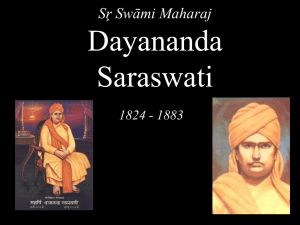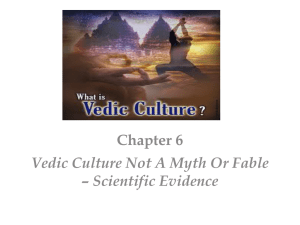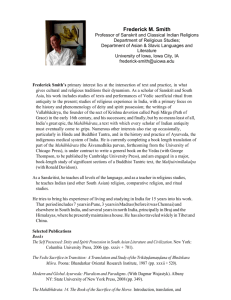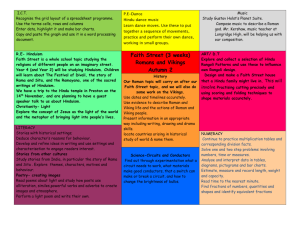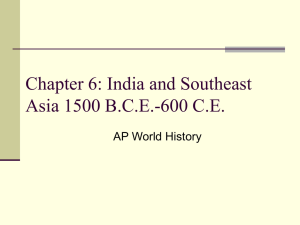Religion and World View - Columbia Center for New Media
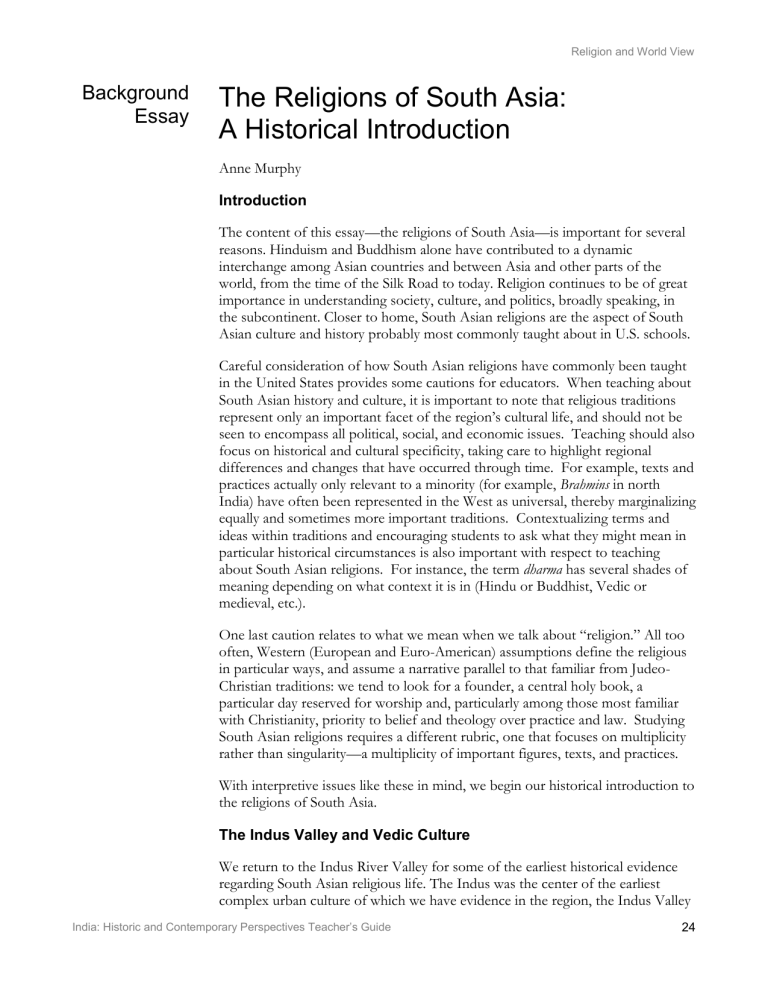
Religion and World View
Background
Essay
The Religions of South Asia:
A Historical Introduction
Anne Murphy
Introduction
The content of this essay—the religions of South Asia—is important for several reasons. Hinduism and Buddhism alone have contributed to a dynamic interchange among Asian countries and between Asia and other parts of the world, from the time of the Silk Road to today. Religion continues to be of great importance in understanding society, culture, and politics, broadly speaking, in the subcontinent. Closer to home, South Asian religions are the aspect of South
Asian culture and history probably most commonly taught about in U.S. schools.
Careful consideration of how South Asian religions have commonly been taught in the United States provides some cautions for educators. When teaching about
South Asian history and culture, it is important to note that religious traditions represent only an important facet of the region’s cultural life, and should not be seen to encompass all political, social, and economic issues. Teaching should also focus on historical and cultural specificity, taking care to highlight regional differences and changes that have occurred through time. For example, texts and practices actually only relevant to a minority (for example, Brahmins in north
India) have often been represented in the West as universal, thereby marginalizing equally and sometimes more important traditions. Contextualizing terms and ideas within traditions and encouraging students to ask what they might mean in particular historical circumstances is also important with respect to teaching about South Asian religions. For instance, the term dharma has several shades of meaning depending on what context it is in (Hindu or Buddhist, Vedic or medieval, etc.).
One last caution relates to what we mean when we talk about “religion.” All too often, Western (European and Euro-American) assumptions define the religious in particular ways, and assume a narrative parallel to that familiar from Judeo-
Christian traditions: we tend to look for a founder, a central holy book, a particular day reserved for worship and, particularly among those most familiar with Christianity, priority to belief and theology over practice and law. Studying
South Asian religions requires a different rubric, one that focuses on multiplicity rather than singularity—a multiplicity of important figures, texts, and practices.
With interpretive issues like these in mind, we begin our historical introduction to the religions of South Asia.
The Indus Valley and Vedic Culture
We return to the Indus River Valley for some of the earliest historical evidence regarding South Asian religious life. The Indus was the center of the earliest complex urban culture of which we have evidence in the region, the Indus Valley
India: Historic and Contemporary Perspectives Teacher’s Guide
24
Religion and World View
Shiva
A major Hindu deity associated with asceticism and yogic practice. He is regarded as the
‘Destroyer,’ and often portrayed in relation to Brahma, the
‘Creator,’ and Vishnu, the ‘Preserver.’
Arya
Indo-European nomandic tribes that migrated from the steppes of southern
Russia into the Indian subcontinent, had cultural ties to the
Greeks and Romans, and spoke Sanskrit.
Varna
‘Color’; A system of social classification described in Sanskrit sources
. or Harappan culture (ca. 2800-1500 B .
C .
E .). Some scholars postulate continuities between elements of the culture, such as possible goddess or fertility worship, and later religious developments in South Asia, such as the growth of the cult of the goddess in Hinduism. Scholars speculate that the great god Shiva, who gained prominence later, may also relate to a figure present on Indus Valley seals.
Similarities between the Indus Valley and later cultures are difficult to verify, because the script found in the Indus Valley is undeciphered and available evidence is entirely material.
In contrast, our understanding of the culture that immediately followed, that of the arya (or “nobles” as they called themselves in their texts), is almost exclusively shaped by literary evidence. By 1200
B .
C .
E
., the Vedic culture of the
arya came to dominate the central plains of the north. Vedic culture is so named for the literature of the period, the Veda. The word veda comes from the Sanskrit root vid (to know) and veda generally means “wisdom,” or in this context, a set of texts that deal primarily with ritual. It is not exactly clear from the available evidence how the arya, their culture, and language came to dominate the area.
Interactions between the arya and other local peoples are to a degree reflected in a late hymn from the Rig Veda (the earliest of the Vedic texts), which describes a hierarchical division of society into four varna or classes: Brahmins or ritual specialists; Kshatriyas or warriors; Vaishyas or merchants; and Shudras, made up of laborers, artisans, and farmers. According to this schema many non-Aryans
(but certainly not all) would have been relegated to the lowest class of Shudras.
This formulation, however, was prescriptive and not descriptive in nature, and therefore does not reveal much about actual social interactions.
Although they do not provide insight into all aspects of society, the Veda do provide insight into the religious life and worldview of the Sanskrit-speaking people, a class of ritual specialists or priests (Brahmins) who transmitted the texts orally within families or lineages for generations. A key concept found in the
Vedic texts is sacrifice, which often involved animals or plants. The ritual acts and associated words were the primary means of communicating with various deities and gaining their favor. The correct ritual action was held to bring about a particular effect if completed correctly.
Prominent among the gods invoked and assuaged through sacrifice was the warrior god Indra, a testament to the militaristic nature of early Indo-Aryan culture, and Agni, the god of fire. Agni is the primary intermediary between the gods and men through the sacrificial fire. Many of the Vedic gods are no longer prominent in contemporary Hinduism, but the Veda are considered to be revelation by many practicing Hindus, and aspects of Vedic practice such as the use of the sacrificial fire continue today.
Foundations of the Contemplative, Renunciatory Model: The
Upanishads
By the middle of the last millennium
B .
C .
E
., the tribal society associated with Vedic culture was settled and urbanized. Within this society, renunciation became a valid social option among diverse sectors, providing space for shramanas, or
India: Historic and Contemporary Perspectives Teacher’s Guide
25
Religion and World View ascetics who sought liberation from the world of suffering through austerity. The
Upanishads, represent these perspectives within orthodox Vedic tradition, without rejecting the authority and primacy of the Veda.
The early Upanishads (from mid-first millennium
B .
C .
E
.) deal with sacrifice but focus on individuals and their relationship with the world. Their primary concern is the hidden connections and equivalences among the world at large, the human self or body, and ritual action—the bindings that join all beings, events, and the world into one. It is in this context that the texts explore the equivalency of
ātman, the self (which can refer both to the spiritual center of a person and the living, breathing person) and Brahman, the divine reality that pervades the cosmos. This equivalency/connection, however, is only one of the many explored in the Upanishads. Others are much more worldly and relate to the physical body and manifest world around us.
Key concepts found in earlier Vedic literature arise in the Upanishadic and other contemporary writings but with profound changes. The cycle of birth and rebirth called samsāra is introduced for the first time in the Upanishads, as is an expanded meaning of karma, which means “action.” In earlier Vedic literature,
karma referred to ritual actions that were governed by a law of cause and effect, not by the will of the gods. The correct ritual action was seen to bring about a particular effect if completed correctly. This process is extended in Upanishadic thought to relate to all actions—they have certain effects according to an immutable law and such effects govern the process of rebirth. The Upanishadic idea of moksha, the possibility of liberation from samsara, was a radically different goal from that encoded into Vedic ritual, which focused on the achievement of certain goals and positive results in this world. The paired concepts of renunciation and enlightenment or release came to have a profound influence upon the development of religious and philosophical thought in South
Asia for millennia. The focus of the Veda on family and society also continued, many times in contexts that owed little allegiance to Vedic thought. The two ideologies have remained in Indian intellectual and religious thought to this day.
Responses to and Reformulation of Vedic traditions: Buddhism and Its Contexts
The changing worldview described in the Upanishads is also evident in two other contemporary major movements, those founded by Mahavira (Jainism) and
Siddhartha Gautama, the Buddha (Buddhism). These shramana movements share much of the basic worldview of the Upanishads but propose radical re-evaluations of Vedic practice and ideology. Both reject the ultimate authority of the Veda, unlike the Upanishadic tradition. hagiography
Biography of a saint or religious figure.
The generally accepted dates for Siddhartha Gautama, the Buddha, are 563–483
B .
C .
E.
Accounts of the Buddha’s life are based on later hagiographies; the actual words of the Buddha were not written down during his own time and the first recordings date from the last century
B .
C .
E .
The Buddha is one of three key elements of Buddhist belief and practice. The other two are dharma (here meaning “teaching”) and sangha (“community of believers”). These three—the
Buddha, dharma, and sangha—are called the three “jewels” of Buddhism and form
India: Historic and Contemporary Perspectives Teacher’s Guide
26
Religion and World View
Cosmology
An understanding of the world within time and space; a worldview. the center of Buddhist religious thought and identity. There is a tendency in the
West to understand Buddhism primarily through textual and philosophical evidence; that is, through a focus on dharma. Buddhism is also the religion lived by the sangha (monks and nuns—representing a radically new social option for women—as well as lay practitioners) and materialized in representations of the
Buddha and sacred sites such as stupas, reliquary monuments holding the remains of the Buddha and other revered persons. Besides the actual teachings and biography of the Buddha, also important are accounts of his past lives, the
Jataka Tales. Memorials and tales of his followers and great saints as well as stories of the myriad beings that are prominent in Buddhist cosmology, play a great role in Buddhist history and ritual.
The Mahāyāna, or “great vehicle,” came into being at the beginning of the
Common Era, and its supporters labeled prior traditions as the Hināyāna or
“lesser vehicle,” reflecting the sometimes-contentious relationship between the two. A series of texts were associated with the Māhayāna, one of them being the
Lotus Sutra, which were not accepted by earlier schools. These texts describe a radically different view of the Buddha as forever present and infinite. The
cosmology of the Buddhist world took on greater detail and complexity and the role of the bodhisattva— one who strives toward enlightenment but remains active in the world for the sake of sentient beings—came to occupy a central place.
Tantra
Important in the Hindu,
Jain, and Buddhist contexts; literally, a type of text that describes ritual practices
( sadhana ) that encourage the transformation of this world into the means toward and experience of enlightenment.
The Buddhist world in the beginning of the first millennium was dynamic and diverse, as the new faith spread out from South Asia to Southeast Asia, China, and beyond. Within South Asia it was centered within large-scale monasteries and scholastic centers, such as that at Nalanda in the Indian state of Bihar. Lay people were active supporters of such establishments, as well as practitioners in their own right. The destruction of major monastic centers by Central Asian
Muslim invaders contributed to the disappearance of Buddhism from India in the twelfth century, but it has thrived into the present in its Māhāyana and Tantric forms in Nepal and Tibet and in its Theravada form in Sri Lanka. Buddhism was also reintroduced into the modern state of India in the twentieth century. The
Jain tradition, on the other hand, has continued uninterrupted into modernity, with the majority of its adherents in western India.
Jati
Literally “birth”; Refers to a hereditary kin group, often set in hierarchical relation to other groups.
Caste
The European term used to describe the system of social hierarchy in India.
There is little doubt that the rejection of Vedic authority by Buddhist and Jain thinkers encouraged the reformulation and strengthening of particular aspects of
Vedic traditions and the reassertion of the authority of Brahmins. Literature of the period helped to codify and reassert aspects of Brahminical ideology. The concept of Four Stages of Life ( āshramadharma) was articulated here, according to which every person must follow the dharma (or social role) assigned to him or her corresponding to his or her place within the varna and jāti hierarchical systems, and corresponding to his (the emphasis here on men) stage in life, or
āshrama. The system defined appropriate roles and responsibilities for men from the upper three castes: Brahmins, Kshatriyas, and Vaishyas. Four stages were identified: celibate student, householder, hermit or forest dwelling (undertaken toward the end of life), and renunciation. Four possible aims in life were identified: artha (economic and social success), dharma (here, learning), kāma
India: Historic and Contemporary Perspectives Teacher’s Guide
27
Religion and World View
Pantheon
Gods considered as a group.
(pleasure), and moksha (liberation). Students were to concentrate on dharma, householders to be concerned with artha and kāma, and only in the final stage of life, that of a wandering holy man, was moksha a goal. The system did not hold for all—particularly for those excluded due to their sex or low position in the varna and jāti systems—and renunciation was never universally embraced, though it remained an ideal. Position in these systems was hereditary, but actual hierarchical relationships were extremely contextually dependent and somewhat fluid.
Puranic and Temple Hinduism and Bhakti
The religion that we now call Hinduism began to take a recognizable shape in the first millennium
C .
E ., drawing upon Vedic roots. In this period, the epics
Mahābhārata (containing the Bhagavad Gītā) and Rāmāyana were composed, along with the Purānas. The Mahābhārata recounts the tragic conflict between the Pāndavas and Kauravas, while the Rāmāyana relates the tale of King Rāma
(an incarnation of Vishnu, see below), who was exiled from his kingdom for 14 years in the company of his wife, Sītā, and his brother Lakshman. These epics have had a profound influence throughout South Asia and even in Southeast
Asia, where Hinduism waned as a primary religious force.
The Purānas provide stories of the gods who were to take a central place within the developing religion now known as Hinduism: Vishnu, Shiva, and the
Goddess, among others. Vaishnavism (the sect of Vishnu), as it developed later, is generally accepted to be an amalgam of many smaller traditions; these were absorbed into the overarching Vishnu tradition through the idea of avatāra, or incarnations (Vishnu is said to have 10 major incarnations who appeared in the world to save it from evil), and into aspects of one personality (such as the various portrayals of Krishna—as a child-god, as the charioteer in the Bhagavad
Gītā, and as the ruler of Dwarka in his adult life). The Goddess takes many forms—some frightening and powerful, some auspicious and gentle. Pārvati,
Lakshmī, Shrī, Kālī, and Durgā are some of the names she goes by. In all forms, she is Devī, “the Goddess.” Shiva is the ultimate ascetic. His body is white from being smeared with the ashes of the cremation ground—an unclean place that reminds us of the temporary nature of existence. His hair is matted and unkempt, and he is known to possess sometimes frightening and dangerous yogic powers. Shiva is also married to Pārvati and is intimately tied to the Goddess in her many other forms as well.
These three divinities—Vishnu, Shiva, and Devi—represent the three main deities worshipped in Hindu practice. Those who worship Vishnu are
Vaishnava, those who worship Shiva are Shaiva, and those who worship the
Goddess are Shakta (from shakti, or “power,” the feminine force that the
Goddess possesses). Although part of the trīmurti (Hindu trinity), Brahma (the
“Creator”) is not often the object of worship. Other deities have gained in popularity, such as Ganesha (the son of Shiva and Pārvati) and Hanuman (the monkey god who aided Rāma in the Rāmāyana). It is important to note that although there are many deities represented in the Hindu pantheon, worshippers generally consider their own deity to be central and all-powerful; other deities are subservient to him or her. In addition, all are often seen to be manifestations of
India: Historic and Contemporary Perspectives Teacher’s Guide
28
Religion and World View
Diaspora
A dispersion of a people from their original homeland.
Tamil
A language that has different linguistic roots from Sanskrit and is mainly spoken in the southeastern Indian state of Tamil Nadu; considered a classical south Indian language.
one central force in the universe. Therefore, many Hindus today (as in the past) see themselves as believing in a single divine presence (referred to in scripture as
Brahman) that takes form in endlessly diverse ways.
In the dynamic urban hubs of the regional kingdoms established in the wake of
Gupta power (after 500
C .
E
.), temples acted as both religious and social centers As regional kings and princes gained power, they often sought legitimacy by granting
Brahmins large areas from which to collect taxes to finance temple development.
Temples provided homes for the Hindu deities, and the images enshrined within represented the deities and in many cases embodied them. Pūja, or “worship,” of the deity, carried out in the home as well in as the temple, became the central focus of religious practice, representing a full transition away from sacrifice as the primary form of religious worship. Pūja remains a central practice in temples all over Hindu South Asia and its diaspora. Home-based rituals have continued to be important; in some contexts, more so than public and congregational forms of worship. The temple, however, was an extremely important institution tied to the growing importance of pilgrimage as a form of religious practice. Temples were often established at holy sites associated with saints and the manifestation of deities.
Bhakti, or “devotion,” transformed both temple-based and personal forms of worship. This movement of ecstatic devotion started in southern India in the eighth century
C .
E
. among saints who sang praises for god in Tamil rather than in
Sanskrit, the language of Vedic orthodoxy. The Puranic deities—Shiva, Vishnu, and Devī —were the foci of radical devotion in Hinduism, but such devotion was central in Buddhist, Jain, and other traditions as well. Devotionalism came to influence and transform Brahminical traditions, just as it gave voice to alternative practices and practitioners such as women and those of lower caste. Bhakti insisted upon the immediate, direct apprehension of the god, whether he/she is contained within a form (such as an image) or unknowable formlessness. The language of intimate relationships was key—poets sang of the god as a devoted lover, parent, or child. Different social positions were represented by bhakti poets such as Ravidas, a chamar (leather worker), and Mirabai, a Rajasthani princess who dared to eschew familial responsibilities in favor of devotion to her Lord and God, Krishna.
Although devotionalism is associated with vernacular languages and texts, it is also found in Sanskrit texts, most notably in the Bhagavad Gītā, which became prominent on a popular level in the modern period. The text describes a conversation between the hero of the Pāndava clan, Arjuna, and Krishna, incarnation of the great god Vishnu. Arjuna balks at fighting in battle against his mentors and relatives. Krishna discusses with him the religious and philosophical implications of his choice, asserting the necessity of fulfilling svadharma (one’s
dharma, or duty) and performing right action without attention to the results of such action. The path of devotion, also called bhakti yoga is identified as a viable means to moksha, alongside the paths of knowledge ( jñāna yoga) and unattached action ( karma yoga). At the end of this section of the Bhagavad Gītā,
Krishna reveals himself in all his glory to Arjuna, and bhakti yoga is revealed as a primary means to reaching god.
India: Historic and Contemporary Perspectives Teacher’s Guide
29
Religion and World View
The Introduction of Islam
In considering South Asian society, we must remember not only to look to the eastern lands where Hinduism and Buddhism and the South Asian languages and cultures associated with them took hold, but also to the west, from where other models of religion, culture, and language were brought into the South Asian world. Adherents of Zoroastrianism (now known as Parsis) came to India in the early eighth century
C .
E
. from Persia, present-day Iran. Islam began to shape the culture and history of South Asia from the end of the first millennium
C .
E
., when Arab traders first came to the shores of Gujarat.
Islam was founded by the Prophet Muhammad in the Arabian Peninsula in the seventh century
C .
E
. and came to exert a profound influence across Asia, Europe, and Africa. Islam provided a monotheistic religious worldview in contrast to the polytheistic system that preceded it in Arabia. The community formed around it—followers of Muhammad and his successors, the Caliphs—came to build a dynamic social and military movement. Muslim power spread out from Arabia in the seventh century and by the eighth century Sindh in modern-day Pakistan was under Muslim rule. The cultures of the Muslim courts in this period absorbed influences of the lands where they were established, and thus the Persian court developed a unique cultural system that integrated Persian elements with Arab
Muslim ones.
Although the first interactions between Muslims and non-Muslims in South Asia took place through trade, the presence of Islam was also strongly shaped by the military campaigns that first brought large numbers of Muslims into the region, establishing Muslim powers in the north and center. Certain elements of Islamic belief, such as its monotheism and eschewal of images in worship, brought about religious conflict in the region. For example, Muslim military campaigns from the
10 th through 12 th centuries were often violent and resulted in the destruction and looting of many Hindu temples. Although this conflict formed a part of the interaction between Muslims and non-Muslims in South Asia, there was great complexity to the interaction among Muslim rulers and their mostly non-Muslim subjects, as well as between those who converted to Islam and those who did not.
Indian art of the period, for example, provides vivid testimony to the way in which West Asian influences were integrated with South Asian styles and techniques, giving birth to a vibrant and unique tradition.
Religiously, the situation was also complex. Law is a central feature of Islamic thought, and Muslim legal representatives became a feature of life in most areas where Islam exerted influence. Scholars of the Islamic tradition wielded considerable influence, but not exclusively. The Mughal emperor Akbar was famous for his interest in all religious traditions, and he encouraged crossreligious dialogue and understanding. Many rulers chose to provide patronage to all religious traditions present within their area of influence. Conversions did not take place on a large scale in all regions, and cannot be attributed to force. Most conversions took place in the outer areas of Bengal and Punjab and were associated with the Muslim mystical movement called Sufism.
India: Historic and Contemporary Perspectives Teacher’s Guide
30
Religion and World View
Sufis, Saints, and Holy Men
Sufi saints shaped the development of popular Islam, just as bhakti saints shaped religious belief and practice among those we now call by the general term
“Hindu.” Like bhakti poets, Sufis (many of them poets as well, like Baba Faud of western Punjab (now Pakistan)) spoke of their direct experience of god and the need to get beyond just formal religious observance to a true and immediate religious engagement. Such religious leaders used similar strategies—the establishment of regional centers open to wide audiences, the appeal to direct and unmediated experience of god, and the validation of aspects of local culture through the establishment of local economic and social imagery in poems.
Popular religious leaders and practices also interacted with more orthodox and established forms as theological speculation and advanced learning in the elite languages of Sanskrit and Arabic continued. Muslim centers—mosques and
madrasas (religious schools)—proliferated, but so too did Hindu sites, although great temple centers were for the most part a thing of the past in the north. The sect of Krishna grew enormously in popularity, and its center south of Delhi became an important pilgrimage site. In the fifteenth century, the famous poet and holy man Kabir was known for his critique of the hollow religiosity of both the Muslim cleric and Hindu Brahmins. He mocked them both and sang of his own direct access to a formless god. It is notable that Kabir’s name is Muslim, but his poetry reveals the influence of Shaivite yogic practices, which illustrates that boundaries between religious groups were not absolute.
The central role of saints and holy men was closely connected to the relationship between guru (teacher) and shishya (student), or in Muslim contexts, pir and
murshid. Lineages are established through succession from teacher to student, developing institutionally over time. Such relationships remain important in the religions of South Asia, as well as in other contexts such as classical music.
Building a community around the guru-shishya relationship was fundamental to the development of Sikhism, one of the world’s newer faiths. Guru Nanak
(1469-1539) formed a community of disciples ( sikhs) after he had a revelation of the formless and inexplicable nature of god. His songs and those of later gurus were recorded in the text known as the Adi Granth, or “First Collection.” His monotheistic vision of god has been seen by many as a compromise between
Hindu and Muslim ideas, but this was apparently not Nanak’s intention. Like other religious speakers of his time, he experienced a religious vision in keeping with the many cultural influences that formed him, but in his own distinctive and unique mode. The community that grew up around him has become a prominent minority in India and around the world.
Reform and Reaffirmation of South Asian Religious Traditions in the Colonial Period
The advent of British power and waning of centralized Mughal power brought about key changes in South Asian religious life in the nineteenth and twentieth centuries. Religions came to be defined in particular ways through the enactment of the census with its discrete categories for “Hindu,” “Muslim,” and for separate castes. In actuality, these categories may have been much more fluid than the
India: Historic and Contemporary Perspectives Teacher’s Guide
31
Religion and World View
Syncretic tradition
Reconciliation or fusion of differing systems of belief, as in philosophy or religion. census allowed for. Many groups—Sikhs, low-caste people, those who followed
syncretic traditions that blended elements of separate religions—were left in the margins and had to fight to be recognized. The cultural critique and racism associated with the colonial regime also meant that many Indians found themselves in defense of “tradition,” and were forced to respond in that mode to the colonial challenge, explicitly or not. Thus Ram Mohan Roy, the famous
Bengali founder of the Brahmo Samaj in 1828, modeled his vision of religious life along pluralistic and universalist grounds. In the late nineteenth century,
Dayanand Saraswati, embracing the Vedic tradition, founded the Arya Samaj and attempted to purge Hinduism of such “impure” elements as image worship
(based on an understanding of Vedic traditions as more authentic, as also articulated by Western Orientalist scholars). This organization was very active in building Hindu consciousness in Punjab and elsewhere.
Certain organizations, educational institutions, and political movements came to be centered around religion as well as caste and other identities. Sir Syed Ahmed
Khan founded Aligarh University to promote the position of Muslims, many of whom (it was argued) had not benefited from colonial patronage as much as
Hindus. Many debates were couched in religious terms. A community sought to gain the patronage and attention of the British administration in accordance with community definitions imposed by the government, and those who could “speak for” a particular group were given the ability to influence government. Different communities came to compete with one another for representation on government committees and in fledgling representational institutions.
Representatives of the Sikhs protested being grouped with Hindus. Among lower caste people, declaring oneself an adherent of “Adi Dharm,” the “original religion” that preexisted Aryan and Vedic influence, was not only a religious choice, but a political one. One’s political affiliation and one’s religion became intimately intertwined as groups of people attempted to align themselves in ways that would allow them a voice within the colonial structure—particularly as the promise of independence took shape. These loyalties and communities were reconfigured and politicized in a way that fundamentally transformed both religious identity and how people engaged in political organization.
It is within this context that one must understand the formation of the nationstates that succeeded the British colonial state through the partition of the subcontinent: India, Pakistan, and after 1971, Bangladesh, formerly East Pakistan.
The call for Pakistan by Jinnah, Muhammad Iqbal, and others only makes sense within the broader context of political reconfiguration that took place within the waning years of British power. Partition was neither inevitable nor necessary, as
South Asian religious history illustrates that both accommodation and conflict among religious groups had coexisted for millennia. During the independence struggle, spaces were constructed around fixed notions of religious identity, simplistic notions of “representativity,” and failed attempts at ensuring the rights of minorities. It is not surprising that religious reconfigurations would mar the great achievement of Indian/Pakistani independence. The scale of the tragedy, however, is. 1947 was the greatest transfer of human populations the world has ever seen, as Hindus, Sikhs, and Muslims left their homes to travel to newly created nation-states: over 13 million refugees were created and half a million
India: Historic and Contemporary Perspectives Teacher’s Guide
32
Religion and World View lives lost. The states of Punjab and Bengal were split in two between the two new nation-states, only to be followed by the splitting of West and East Pakistan into Pakistan and Bangladesh in 1971.
To the Present
—Conflict, Accommodation, New Directions
Change and continuity still characterize the development of religious traditions in
South Asia as they have in the past. India, the world’s largest democracy, has seen periods of great triumphs in the formation of modern religious identities and practices, as well as great tragedies. Caste continues to exert a profound influence both in individual lives and in regional and national politics. However, leaders like
Ambedkar, who chose to convert to Buddhism to combat the stigma of
Untouchability, and others have challenged the status quo like the bhakti poets and Buddhist thinkers of centuries ago. The legal system in India has retained differing systems for Hindu and Muslim personal law (more than 10 percent of the population of India is Muslim). Sikhs have battled for their own homeland, although since 1997 a relative peace has returned to the Punjab. Radical rightwing Hinduism, especially after the destruction of the mosque at Ayodhya in
1992, has raised concerns for all religious minorities in the region—Sikh, Muslim, and Christian alike. Pakistan and Bangladesh have experimented to different degrees with the integration of Islamic legal structures into the running of the nation-state, but in neither nation has conservative Islam exerted an absolute influence on governance. South Asia’s dynamic religious present is manifested throughout the world, since the South Asian diaspora is a vital and growing community. Religious traditions are transformed by this increasingly small world, influenced by economic and political change, new media, and changing social expectations.
Anne Murphy is a doctoral candidate in the Department of Religion at Columbia University.
She specializes in interactions among North Indian religions, with a special focus on the Sikh tradition; Punjabi history and literature; the South Asian Diaspora; art; and museum studies.
She is a former New York City public school teacher and has remained active in education while pursuing her scholarly interests.
India: Historic and Contemporary Perspectives Teacher’s Guide
33
